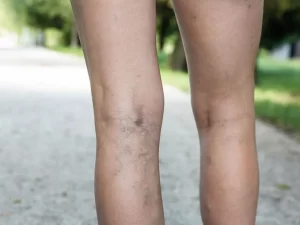
Varicose veins are enlarged and swollen veins that often appear dark blue or purple. They usually develop in the legs and feet, but can occur in other areas of the body as well. Varicose veins occur when the veins in the legs or feet become damaged or weakened, causing blood to flow back into the vein and pool there.
The most common symptoms of varicose veins include:
- Visible swollen veins
- Aching, throbbing, or cramping in the legs
- Swelling in the feet or ankles
- Itchy or burning skin around the affected vein
- Muscle fatigue or heaviness in the legs
- Skin discolouration or ulcers near the affected vein
Several factors can increase the risk of developing varicose veins, including age, genetics, pregnancy, obesity, and prolonged standing or sitting.
Treatment options for varicose veins include lifestyle changes, such as exercise and weight loss, wearing compression stockings to improve circulation, and medical procedures such as endovenous laser treatment or sclerotherapy, which involves injecting a solution into the affected vein to close it off.
If you suspect you have varicose veins or are experiencing symptoms, it is important to speak with your healthcare provider for an accurate diagnosis and to discuss appropriate treatment options.
